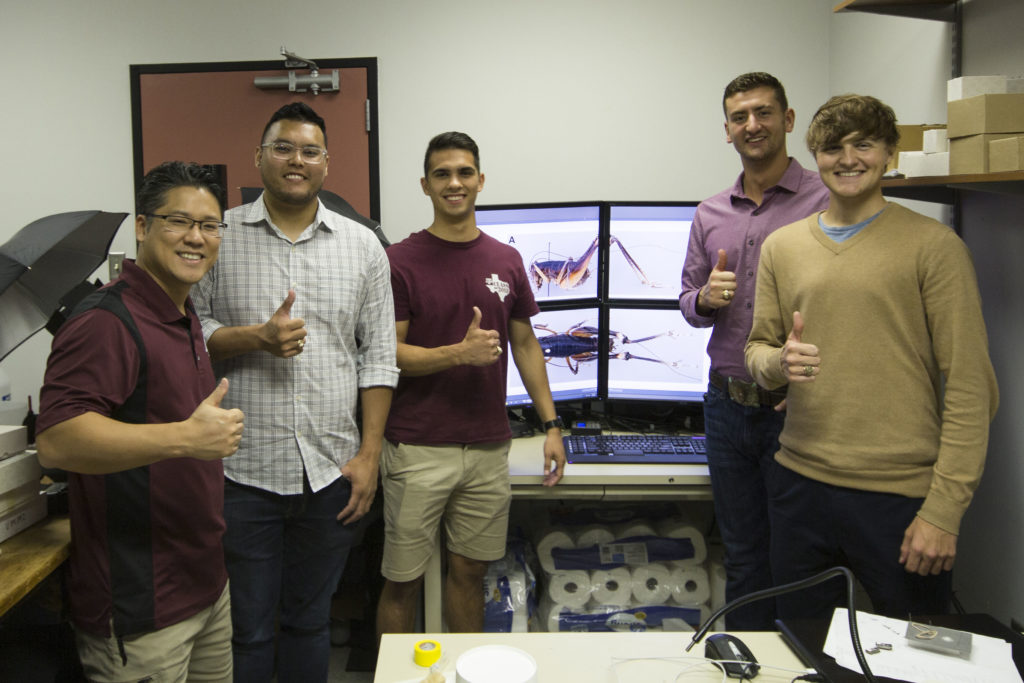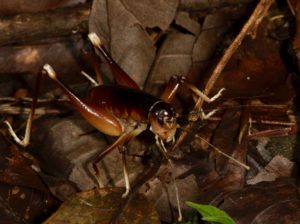Study abroad trip to Costa Rica leads to new king cricket species discovery

A group of four Texas A&M Department of Entomology undergraduate students took their knowledge from the classroom and put it to use in discovering a new species of king cricket during a recent study abroad trip to Costa Rica.
Under the guidance of Hojun Song, Ph.D., associate professor for entomology, students Steven Richardson, Travis Trimm, Randell Paredes and Jonathan Koehl described a new species of king cricket, Glaphyrosoma stephanosoltis, Orthoptera Anostostomatidae, from the tropical rainforests near the Soltis Center for Research and Education in San Isidro.
A new species of king cricket

“Last year, these four students worked with a king cricket species that was very common in the forest floors near the Soltis Center,” Song said. “While working on their project, it became evident that the species, which was so abundant, was actually new to science because we couldn’t identify them down to species.”
The students’ discovery was recorded in the journal Zootaxa in September. The group found the new species while working on a research project about cricket feeding habits during a two-week course titled “Field Entomology in the Tropics” last summer.
The crickets were hand-collected along the trails in the secondary rainforest near the Soltis Center.
Song said the group then brought the cricket specimens back to his lab in College Station, and throughout the fall semester, he taught the students how to properly describe the new species by reviewing taxonomic literature, taking photographs, measuring specimens and illustrating the important features.
The first author of the publication, Richardson, proposed the new species to be named after the Soltis Center. The species name “stephanosoltis” means “the Crown of Soltis” referring to the first king cricket species ever to be described in conjunction with the Soltis Center.
According to the paper, the new species of crickets represents the southernmost distribution of the genus Glaphyrosoma Brunner von Wattenwyl that is widely distributed throughout Mexico, Guatemala and Honduras. This new species is distributed throughout the Alajuela Province on the rainforest floor in the northernmost part of Costa Rica.
The students also observed the crickets liked to hide under torn leaves and branches as well as the overhanging soil underside along trails or tunnels made by other burrowing animals. They theorized the species most likely lives underground to avoid desiccation, or extreme dehydration.
The students were able to collect the crickets using oatmeal baits laid out on the forest floor at night. During their study abroad, they found the crickets showed an overwhelming preference for eating the leaves of native plants, but when kept in the cage, they preferred feeding on dead crickets and katydids.
Song said developing awareness about biodiversity is key to conservation, and the students were able to take part in this important endeavor.
“Every day we see habitat destruction and urbanization, which has a profound impact on biodiversity,” he said. “We probably know less than 10% of what is out there, and we’re driving them to extinction without knowing what species are out there. The only way to protect biodiversity is to first know biodiversity. In that regard, describing a new species is a critically important component of biodiversity conservation.”
Study Abroad

“Study abroad programs are designed to take them out of their comfort zone and expose them to the real world,” Song said. “Once you start looking around, you experience different cultures and ideas and begin to appreciate the diversity. The paper is a direct result of some students taking that leap to experience a completely different environmental setting from Texas and engage in a highly experiential learning experience.”
There are several study programs held at the Soltis Center, but the “Field Entomology in the Tropics” is the only course that actually utilizes the adjacent rainforests as a place for teaching biodiversity, he explained. “There are still many new species to discover right in the backyard of the Soltis Center, and doing that with the students who have taken a study abroad course demonstrates an amazing educational opportunity.”
The discovery of the crickets also showed how important the Soltis Center is in promoting the vision of providing high-impact, international study opportunities to students.
The Soltis Center for Research and Education
The Soltis Center was established in January 2009 as a result of the vision and donation of Bill Soltis ’55 and his wife, Wanda.
The center was created with a vision to provide international experiences for Aggies while protecting the unique ecological setting around the center and creating preservation awareness. The Soltis Center is celebrating its 10-year anniversary this year, and Song said this new king cricket named after the center shows the students’ appreciation for Soltis’ vision.
“I really enjoyed my time at the center,” Richardson said. “We were always doing something with collecting, excursions or running our experiment. And when we did have free time, I was out collecting insects anyway. It was an incredible experience, and if I ever got the opportunity to go back for longer, I would.”


